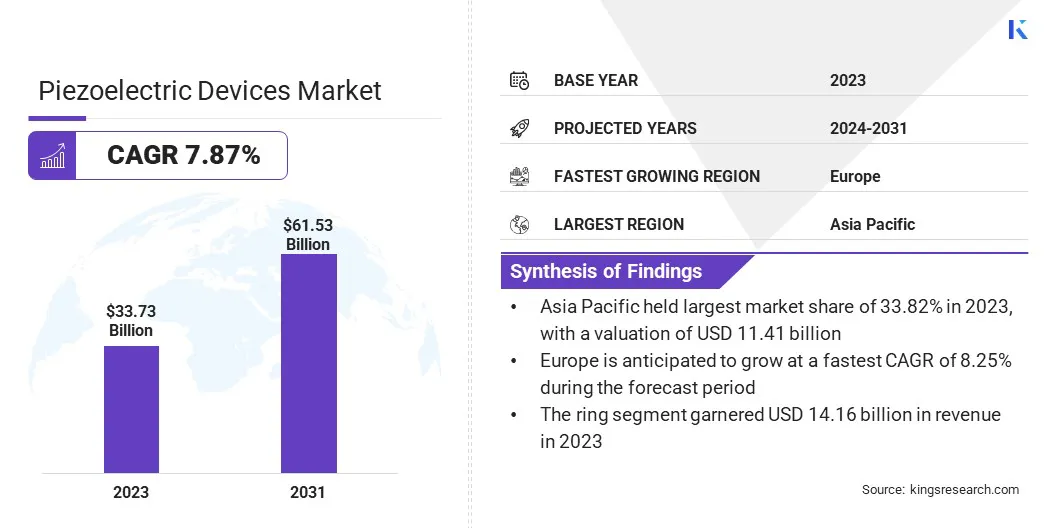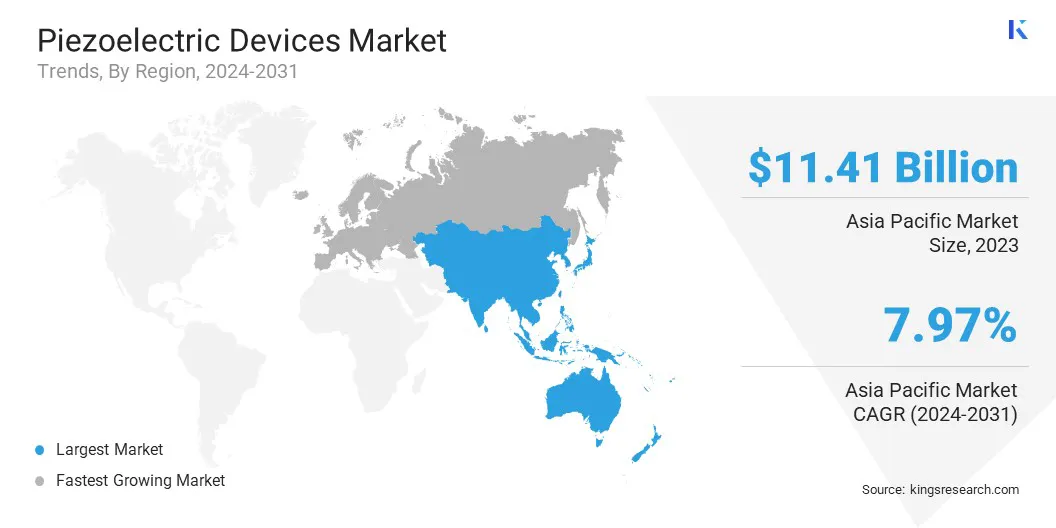Market Definition
The market involves the development and manufacturing of devices that use piezoelectric materials. These materials generate an electric charge when mechanically stressed, meaning they can convert mechanical energy into electrical energy and vice versa.
The report delves into the critical drivers fueling market development, while offering a detailed regional analysis and an overview of the competitive landscape shaping future opportunities.
Piezoelectric Devices Market Overview
The global piezoelectric devices market size was valued at USD 33.73 billion in 2023, which is estimated to be USD 36.21 billion in 2024 and reach USD 61.53 billion by 2031, growing at a CAGR of 7.87% from 2024 to 2031.
Advancements in piezoelectric thin films to enhance efficiency and performance are driving the demand for piezoelectric devices. This improvement fuels growth in sectors like medical, consumer electronics, and energy harvesting.
Major companies operating in the piezoelectric devices industry are CeramTec GmbH, CTS Corporation, Kistler Group, Physik Instrumente (PI) SE & Co. KG, APC International, Ltd.’s, piezosystem jena, YAGEO Group, Amphenol Corporation, Mad City Labs Inc., TE Connectivity, Mide Technology Corp., Omega Piezo Technologies, PCB Piezotronics, Inc., acuvi, and Murata Manufacturing Co., Ltd.
The wearable technology market is rapidly expanding, with piezoelectric devices playing a crucial role in enhancing device functionality. Piezoelectric sensors and actuators are increasingly integrated into smart wearables for motion sensing, haptic feedback, and energy harvesting.
These technologies allow for more efficient, self-powered devices with improved user experiences. The demand for wearables is growing, especially in health, fitness, and entertainment sectors. This makes piezoelectric devices essential for developing advanced, compact, and energy-efficient solutions, offering significant growth opportunities in the market.
- In August 2023, the Korea Advanced Institute of Science and Technology (KAIST) research team developed a wearable piezoelectric blood pressure sensor for continuous health monitoring. This breakthrough offers highly accurate, non-invasive blood pressure measurement, addressing limitations in current wearable devices and presenting significant opportunities in healthcare technology.

Key Highlights:
- The piezoelectric devices industry size was valued at USD 33.73 billion in 2023.
- The market is projected to grow at a CAGR of 7.87% from 2024 to 2031.
- Asia Pacific held a market share of 33.82% in 2023, with a valuation of USD 41 billion.
- The ring segment garnered USD 14.16 billion in revenue in 2023.
- The sensors segment is expected to reach USD 17.54 billion by 2031.
- The consumer electronics segment is anticipated to register the fastest CAGR of 8.18% during the forecast period.
- The market in Europe is anticipated to grow at a CAGR of 8.25% during the forecast period.
Market Driver
Enhanced Performance of Piezoelectric Materials
The enhanced performance of piezoelectric materials, such as the breakthrough in sodium niobate (NaNbO3) thin films, significantly improves the efficiency and capabilities of piezoelectric devices. These advancements lead to higher electromechanical response and precision, increasing the utility of piezoelectric technologies across a variety of sectors.
Applications in medical devices, consumer electronics, and energy harvesting benefit from these improvements, as the devices become more efficient, compact, and reliable. This factor drives the market.
- In September 2024, an international team led by Nanyang Technological University (NTU) professors achieved a breakthrough in piezoelectric thin films. Their method increased the electromechanical response, enabling more efficient and miniaturized devices, which is expected to drive growth in applications like MEMS, sensors, and energy harvesters.
Market Challenge
Technical Limitations
One of the key challenges faced by the piezoelectric devices market is the sensitivity limitations of certain materials, as well as their susceptibility to temperature fluctuations and aging effects. These factors can reduce performance and reliability over time, particularly in demanding applications like sensors and actuators.
Researchers are developing advanced materials and engineering techniques, such as the use of lead-free, high-performance piezoelectric films and improved material compositions, to enhance stability, longevity, and overall device efficiency across varying environmental conditions.
Market Trend
Sustainable Power Solutions
The growing emphasis on sustainable, clean energy solutions is driving the development of piezoelectric technologies that can generate electricity from small vibrations. This trend reflects the shift toward reducing reliance on conventional power sources, such as batteries and fossil fuels.
Piezoelectric devices offer a more eco-friendly and self-sustaining energy solution by harnessing mechanical energy from everyday movements or vibrations. These technologies are increasingly being integrated into consumer electronics, wearables, and industrial applications, promoting efficiency while supporting environmental sustainability.
- In November 2024, researchers at the University of Waterloo developed a wearable generator that powers electronics through body movements, using piezoelectric materials. This innovation promises low-cost, flexible, energy-efficient solutions for sustainable energy, advancing applications in electronics and aviation.
Piezoelectric Devices Market Report Snapshot
|
Segmentation
|
Details
|
|
By Type
|
Disc, Plate, Ring
|
|
By Application
|
Sensors, Transducers, Motors, Actuators, Others
|
|
By End-usese Industry
|
Manufacturing, Automotive, Healthcare, Aerospace & Defense, Consumer Electronics, Others
|
|
By Region
|
North America: U.S., Canada, Mexico
|
|
Europe: France, UK, Spain, Germany, Italy, Russia, Rest of Europe
|
|
Asia-Pacific: China, Japan, India, Australia, ASEAN, South Korea, Rest of Asia-Pacific
|
|
Middle East & Africa: Turkey, UAE, Saudi Arabia, South Africa, Rest of Middle East & Africa
|
|
South America: Brazil, Argentina, Rest of South America
|
Market Segmentation:
- By Type (Disc, Plate, Ring): The ring segment earned USD 14.16 billion in 2023, due to the increasing demand for wearable devices and energy-efficient solutions.
- By Application (Sensors, Transducers, Motors, Actuators, Others): The sensors segment held 28.47% share of the market in 2023, due to their widespread adoption in automotive, healthcare, and industrial applications.
- By End-usese Industry (Manufacturing, Automotive, Healthcare, Aerospace & Defense, Consumer Electronics, Others): The manufacturing segment is projected to reach USD 18.42 billion by 2031, owing to advancements in automation and piezoelectric materials.
Piezoelectric Devices Market Regional Analysis
Based on region, the global market has been classified into North America, Europe, Asia Pacific, Middle East & Africa, and Latin America.

Asia Pacific accounted for a market share of around 33.82% in 2023, with a valuation of USD 11.41 billion. Asia-Pacific continues to dominate the global piezoelectric devices market, due to its strong manufacturing base, technological advancements, and the widespread adoption of piezoelectric devices across industries such as automotive, consumer electronics, and healthcare.
Countries like China, Japan, and South Korea are major players, benefiting from robust Research and Development (R&D) investments, as well as the growing demand for energy-efficient and compact devices. The region’s rapid industrialization, coupled with a high demand for automation, makes it a key market for piezoelectric technologies.
The market in Europe is poised for significant growth at a robust CAGR of 8.25% over the forecast period. Europe is emerging as the fastest-growing region in the piezoelectric devices industry, driven by increasing focus on sustainable energy solutions and technological innovation.
The Piezo Institute, Europe’s first dedicated center for multifunctional piezoelectric devices, fosters research, education, and industry engagement. Supported by the EU, it aims to enhance healthcare, sensing, and energy harvesting technologies, transitioning from a non-profit to a self-sustaining entity.
The demand for advanced piezoelectric materials in automotive, healthcare, and industrial applications is fueling the market. Countries like Germany, France, and the UK are investing heavily in R&D, particularly for energy harvesting and sensors. The shift toward eco-friendly technologies and smart devices is anticipated to propel the market in Europe, positioning it as a leader in piezoelectric advancements.
Regulatory Frameworks
- In India, the Bureau of Indian Standards (BIS) serves as the regulatory body responsible for setting standards for electronic materials, including piezoelectric devices.
- In the EU, CE marking ensures that piezoelectric devices comply with safety, health, and environmental protection standards before being sold in the European Economic Area (EEA), promoting consumer safety and facilitating free market access within the region.
- In the U.S., the Environmental Protection Agency (EPA) ensures compliance with environmental standards related to waste disposal and manufacturing processes of piezoelectric devices, aiming to minimize environmental impact and promote sustainability.
Competitive Landscape:
Companies in the piezoelectric devices market are focusing on developing innovative solutions to enhance energy efficiency and device performance. They are investing in advanced materials, such as flexible and lead-free piezoelectric materials, and integrating these technologies into various industries, including automotive, healthcare, and consumer electronics.
Additionally, businesses are prioritizing sustainability by improving manufacturing processes, reducing costs, and creating devices with higher sensitivity and longer operational lifespans to meet evolving market demands.
- In February 2025, Kistler introduced its optimized maXYmos BL 5867C process monitoring system, enhancing force-displacement monitoring in industrial production. This system supports piezoelectric devices, improving quality assurance in industries such as medical technology, automotive, and electronics with cost-efficient integration.
List of Key Companies in Piezoelectric Devices Market:
- CeramTec GmbH
- CTS Corporation
- Kistler Group
- Physik Instrumente (PI) SE & Co. KG
- APC International, Ltd.’s
- piezosystem jena
- YAGEO Group
- Amphenol Corporation
- Mad City Labs Inc.
- TE Connectivity
- Mide Technology Corp.
- Omega Piezo Technologies
- PCB Piezotronics, Inc.
- acuvi
- Murata Manufacturing Co., Ltd.
Recent Developments (Product Launch)
- In February 2025, Kistler launched an advanced piezoelectric cylinder pressure sensor, designed to optimize the performance of high-efficiency combustion engines. This breakthrough highlights the increasing demand for piezoelectric devices in industrial applications, improving precision and efficiency. The sensor’s integration into engine systems underlines the expanding role of piezoelectric technology in driving innovation across multiple sectors, particularly automotive and manufacturing.


